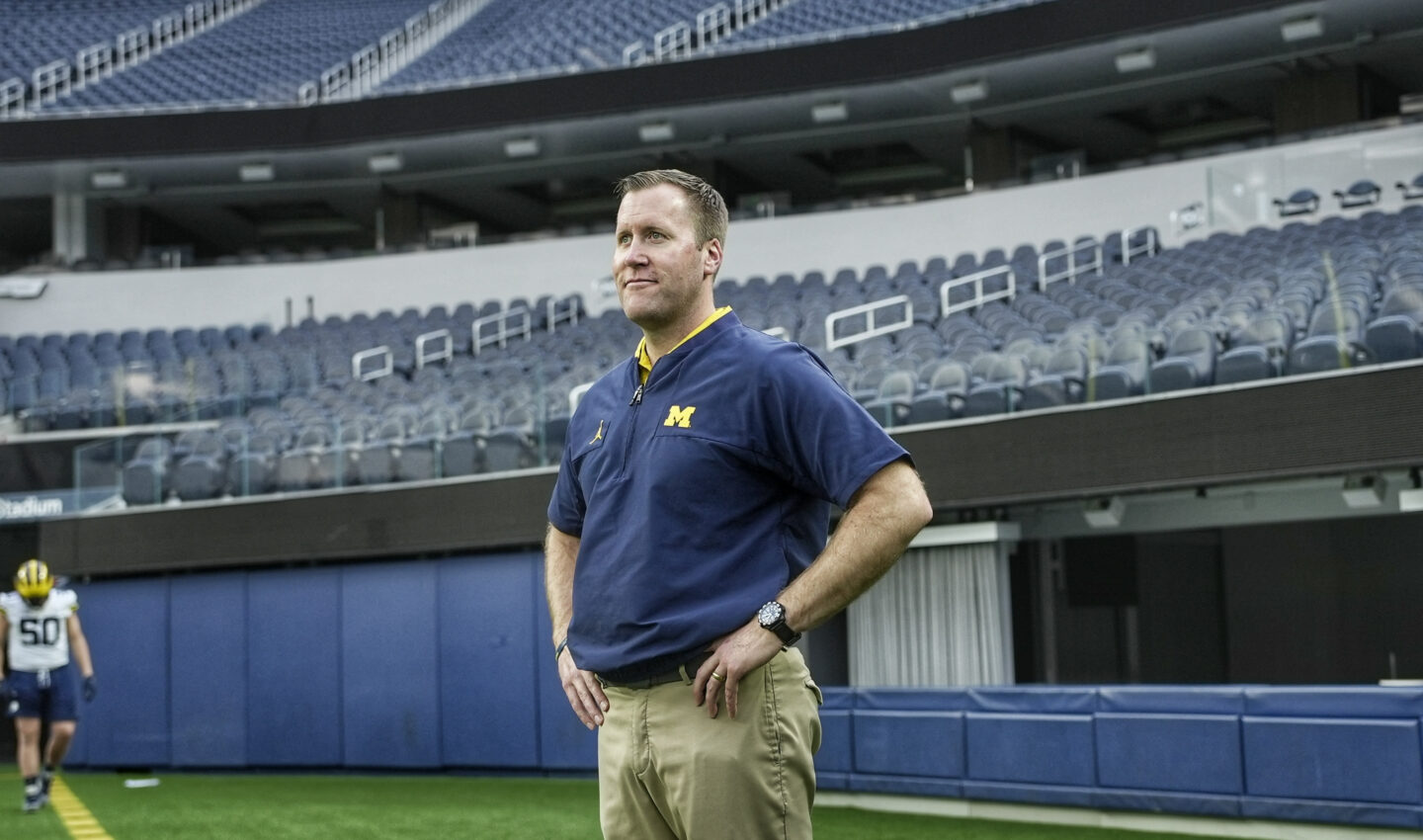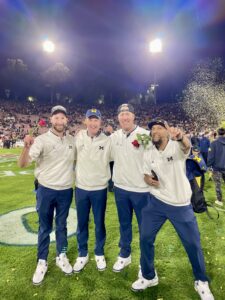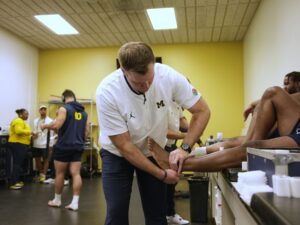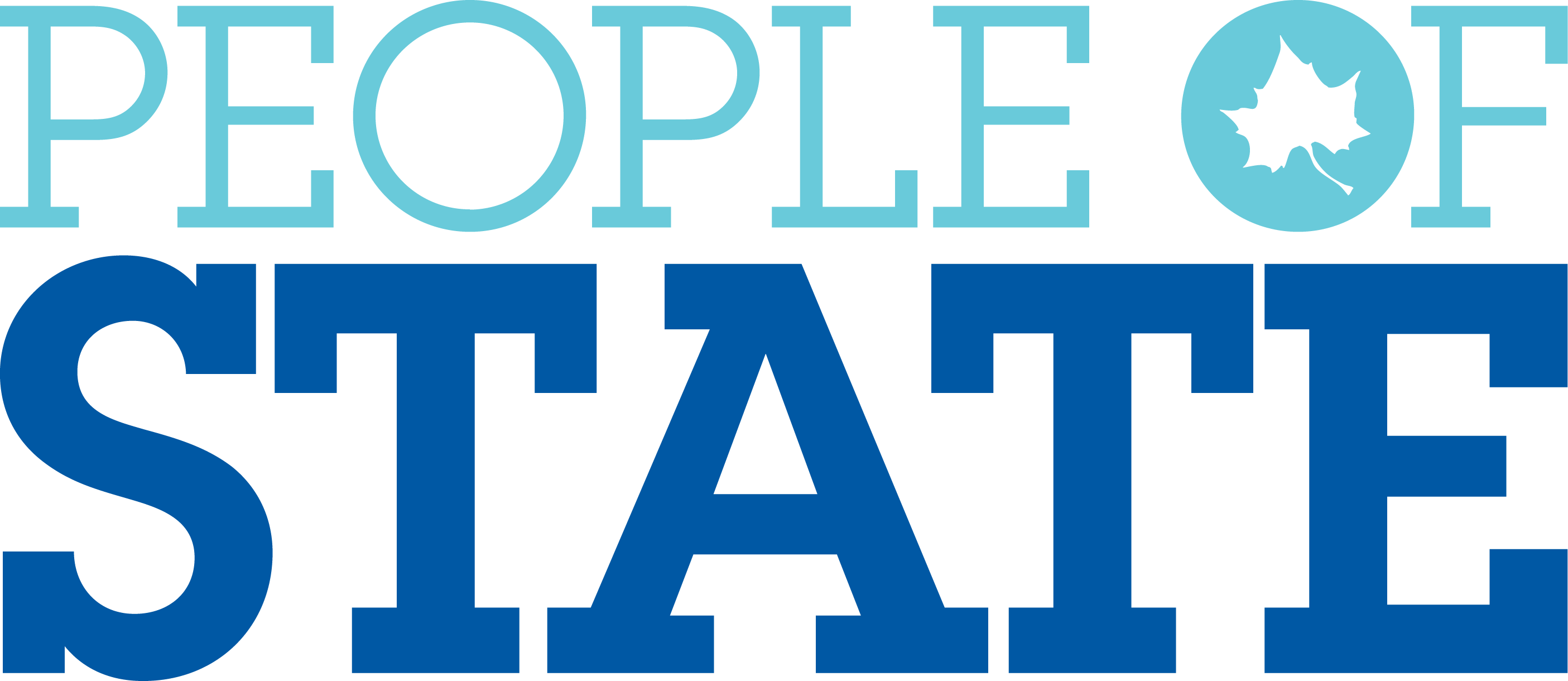
Steve Smith
By Kasy Long
Jan 4, 2024
When University of Michigan football players, coaches, and support staff celebrated the Wolverines’ Rose Bowl victory over Alabama on New Year’s Day, one proud Sycamore was part of that joyous scene in Pasadena.
Steve Smith, a 2019 graduate of Indiana State University’s Doctorate of Athletic Training (DAT) program, is one of nine members of undefeated Michigan’s athletic training staff. And now, he’s busy helping the team physically prepare to take on the University of Washington Huskies in the College Football Playoff National Championship on Monday, January 8 in Houston.

Steve Smith (second from right) with other University of Michigan athletic trainers at the Rose Bowl on January 1.
Smith has helped diagnose, treat, and prevent muscle and bone injuries and illnesses for college student-athletes since 2006. Before joining the Wolverines, he spent eight years working with soccer, lacrosse, and football at the University of Notre Dame, three years assisting a variety of teams at Eastern Michigan University, and two years as a graduate assistant at Grand Valley State University. Smith is in his fifth year as part of Michigan’s football staff.
“Athletic trainers wear many different hats. We build relationships with athletes while helping them play their best,” Smith says. “I love football. It’s an exciting sport because so much is happening all at once. Working with college football players is exciting because you get to watch them grow in four years. You can be a mentor and see their progress. I wouldn’t want to do anything else.”
Along the way, Smith completed his DAT degree – a hybrid program that involved online education and visits to Indiana State’s campus for hands-on instruction and personal interaction with faculty members.
The program helps Indiana State students become patient-centered, clinically expert practitioners who understand patients’ specific health and wellness needs. Every patient Smith cares for has a unique background and injuries that require individualized treatment techniques. DAT students at Indiana State develop their skills using practice-based research and advanced research projects that are relevant to their specific career goals in athletic training.
“Indiana State pushed me as an athletic trainer to think about the profession in a different way,” Smith explains. “I developed a greater understanding of athletic training. The DAT program is collaborative, and the caring, dedicated faculty empowered me to be a leader in the profession.”
Smith says he still considers his faculty at Indiana State to be mentors and colleagues, and that they were cooperative and supportive as he completed his doctorate while working at Notre Dame.

Smith’s research in the DAT program focused on athletic training documentation. He provided educational lectures on the importance of documentation in sports injuries. Because athletic training staff members have such busy schedules, documentation can be neglected, he says.
“Documenting injuries can lead to more accurate injury reports. When there are multiple athletic trainers, it’s important to work together and communicate effectively so everyone is on the same page when addressing these injuries,” Smith explains.
During his research, Smith also developed a passion for strengthening feet and ankle stability in athletes. He tested ankle braces to see how they would assist in repairing injuries in football players. Smith works with student-athletes to restore their joint function and ankle mobility while finetuning their balance and body movements.
Smith’s other responsibilities as athletic trainer include taping body joints, braces, and pads onto athletes to brace them for the physical impact involved in today’s collegiate sports. If athletes are injured or sore, an athletic trainer may work with them three times a day – behind the scenes during a game and even well before – to make sure they’re ready to perform at their peak ability.
Michigan Head Coach Jim Harbaugh heaped praise on the team’s athletic training staff, including Smith, as the team prepared for a game during the 2022 season.
“I’ve never seen the type of effort put in this week by the medical staff, the athletic trainers in particular. If [players] weren’t in class, they were in that training room. It was an incredible effort by our training staff,” the coach remarked. “[I’m] just so darn appreciative, respectful, and [have] so much gratitude for the hours they work and the effort put in.”
Smith knows that injuries are inevitable in college athletics.
“When athletes are injured on the field, we do a brief evaluation on the field and determine if it’s safe for them to move. If so, we move them to a sideline tent to take more time to assess the severity of the injury. This injury is reported [to coaches] and we work on the situation while the game resumes,” Smith explains.
He’s proud of those student-athletes who “put in the hard work” during their recovery to return to the field stronger and possibly better physically than they were before the injury.
“As athletic trainers, we form relationships with our student-athletes. It’s a great feeling to see an athlete work hard and not give up. They come back to the game, and it’s fun to be a part of their success,” Smith says.
Now Smith will join the Wolverines on the sidelines in Monday’s College Football Playoff National Championship Game in Houston. Along with the rest of the team’s devoted fans, he’ll Hail for the Victors and Michigan’s student-athletes as they take the field on the biggest stage in college football.
In his case, Smith will also be hoping for no injuries and, of course, a championship trophy.

